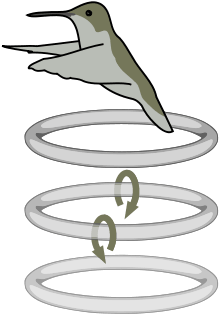Hummingbird
Hummingbirds are birds native to the Americas and constituting the biological family Trochilidae. They are the smallest of birds, most species measuring 7.5–13 cm (3–5 in) in length. The smallest extant hummingbird species is the 5 cm (2.0 in) bee hummingbird, which weighs less than 2.0 g (0.07 oz). The largest hummingbird species is the 23 cm (9.1 in) giant hummingbird, weighing 18–24g (0.63–0.85 oz).
| Hummingbird | |
|---|---|
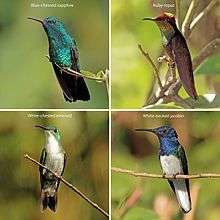 | |
| Four hummingbirds from Trinidad and Tobago | |
| Scientific classification | |
| Kingdom: | Animalia |
| Phylum: | Chordata |
| Class: | Aves |
| Order: | Apodiformes |
| Family: | Trochilidae Vigors, 1825 |
| Subfamilies | |
|
Phaethornithinae
| |
They are known as hummingbirds because of the humming sound created by their beating wings, which flap at high frequencies audible to humans. They hover in mid-air at rapid wing-flapping rates, which vary from around 12 beats per second in the largest species, to in excess of 80 in some of the smallest. Of those species that have been measured in wind tunnels, their top speeds exceed 15 m/s (54 km/h; 34 mph) and some species can dive at speeds in excess of 22 m/s (79 km/h; 49 mph).[1][2]
Hummingbirds have the highest mass-specific metabolic rate of any homeothermic animal.[3] To conserve energy when food is scarce, and nightly when not foraging, they can go into torpor, a state similar to hibernation, slowing their metabolic rate to 1/15th of its normal rate.[4]
Evolution
A map of the hummingbird family tree – reconstructed from analysis of 284 of the world's 338 known species – shows rapid diversification from 22 million years ago.[5] Hummingbirds fall into nine main clades, the topazes, hermits, mangoes, brilliants, coquettes, Patagona, mountain gems, bees, and emeralds, defining their relationship to nectar-bearing flowering plants and the birds' continued spread into new geographic areas.[5][6][7][8]
While all hummingbirds depend on flower nectar to fuel their high metabolisms and hovering flight, coordinated changes in flower and bill shape stimulated the formation of new species of hummingbirds and plants. Due to this exceptional evolutionary pattern, as many as 140 hummingbird species can coexist in a specific region, such as the Andes range.[5]
The hummingbird evolutionary tree shows ancestral hummingbirds splitting from insectivorous swifts (family Apodidae) and treeswifts (family Hemiprocnidae) about 42 million years ago, probably in Eurasia.[5] One key evolutionary factor appears to have been an altered taste receptor that enabled hummingbirds to seek nectar.[9] By 22 million years ago the ancestral species of current hummingbirds became established in South America, where environmental conditions stimulated further diversification.[5]
The Andes Mountains appear to be a particularly rich environment for hummingbird evolution because diversification occurred simultaneously with mountain uplift over the past 10 million years.[5] Hummingbirds remain in dynamic diversification inhabiting ecological regions across South America, North America, and the Caribbean, indicating an enlarging evolutionary radiation.[5]
Within the same geographic region, hummingbird clades co-evolved with nectar-bearing plant clades, affecting mechanisms of pollination.[10][11] The same is true for the sword-billed hummingbird (Ensifera ensifera), one of the morphologically most extreme species, and one of its main food plant clades (Passiflora section Tacsonia).[12]
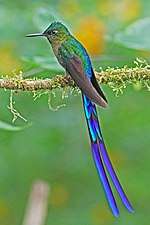
_JCB.jpg)
Sexual dimorphisms
Hummingbirds exhibit sexual size dimorphism according to Rensch's rule,[13] in which males are smaller than females in small species, and males are larger than females in large-bodied species.[14] The extent of this sexual size difference varies among clades of hummingbirds.[14][15] For example, the Mellisugini clade exhibits a large size dimorphism, with females being larger than males.[15] Conversely, the Lophomithini clade displays very little size dimorphism; males and females are similar in size.[15] Sexual dimorphisms in bill size and shape are also present between male and female hummingbirds,[15] where in many clades, females have longer, more curved bills favored for accessing nectar from tall flowers.[16] For males and females of the same size, females will tend to have larger bills.[15]
Sexual size and bill differences likely evolved due to constraints imposed by courtship because mating displays of male hummingbirds require complex aerial maneuvers.[13] Males tend to be smaller than females, allowing conservation of energy to forage competitively and participate more frequently in courtship.[13] Thus, sexual selection will favor smaller male hummingbirds.[13]
Female hummingbirds tend to be larger, requiring more energy, with longer beaks that allow for more effective reach into crevices of tall flowers for nectar.[16] Thus females are better at foraging, acquiring flower nectar, and supporting the energy demands of their larger body size.[16] Directional selection will thus favor the larger hummingbirds in terms of acquiring food.[14]
Another evolutionary cause of this sexual bill dimorphism is that the selective forces from competition for nectar between the sexes of each species are what drive the sexual dimorphism.[15] Depending on which sex holds territory in the species, it is advantageous for the other sex to have a longer bill and be able to feed on a wide variety of flowers, decreasing intraspecific competition.[16] For example, in species of hummingbirds where males have longer bills, males do not hold a specific territory and have a lek mating system.[16] In species where males have shorter bills than females, males defend their resources and therefore females must have a longer bill in order to feed from a broader range of flowers.[16]
Co-evolution with ornithophilous flowers
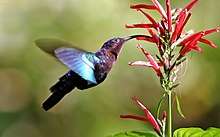
Hummingbirds are specialized nectarivores[17] and are tied to the ornithophilous flowers upon which they feed. This coevolution implies that morphological traits of hummingbirds, such as bill length, bill curvature, and body mass are correlated with morphological traits of plants, for example corolla length, curvature, and volume.[18] Some species, especially those with unusual bill shapes, such as the sword-billed hummingbird and the sicklebills, are co-evolved with a small number of flower species. However, even in the most specialized hummingbird-plant mutualisms the number of food plant lineages of the individual hummingbird species increases with time.[19] The bee hummingbird (Mellisuga helenae) – the world's smallest bird – evolved to dwarfism likely because it had to compete with long-billed hummingbirds having an advantage for nectar foraging from specialized flowers, consequently leading the bee hummingbird to more successfully compete for flower foraging against insects.[20][21]
Many plants pollinated by hummingbirds produce flowers in shades of red, orange, and bright pink, though the birds will take nectar from flowers of other colors as well. Hummingbirds can see wavelengths into the near-ultraviolet, but hummingbird-pollinated flowers do not reflect these wavelengths as many insect-pollinated flowers do. This narrow color spectrum may render hummingbird-pollinated flowers relatively inconspicuous to most insects, thereby reducing nectar robbing.[22][23] Hummingbird-pollinated flowers also produce relatively weak nectar (averaging 25% sugars w/w) containing a high proportion of sucrose, whereas insect-pollinated flowers typically produce more concentrated nectars dominated by fructose and glucose.[24]
Bill evolution
Upon maturity, males of a particular species, Phaethornis longirostris, the long-billed hermit, appear to be evolving a daggerlike weapon on the beak tip as a secondary sexual trait to defend mating areas.[25]
Systematics

In traditional taxonomy, hummingbirds are placed in the order Apodiformes, which also contains the swifts. However, some taxonomists have separated them into their own order, the Trochiliformes. Hummingbirds' wing bones are hollow and fragile, making fossilization difficult and leaving their evolutionary history poorly documented. Though scientists theorize that hummingbirds originated in South America, where species diversity is greatest, possible ancestors of extant hummingbirds may have lived in parts of Europe to what is southern Russia today.[26]
Between 325 and 340 species of hummingbirds are described, depending on taxonomic viewpoint, divided into two subfamilies, the hermits (subfamily Phaethornithinae, 34 species in six genera), and the typical hummingbirds (subfamily Trochilinae, all the others). However, recent phylogenetic analyses suggest that this division is slightly inaccurate, and that there are nine major clades of hummingbirds: the topazes and jacobins, the hermits, the mangoes, the coquettes, the brilliants, the giant hummingbird (Patagona gigas), the mountaingems, the bees, and the emeralds.[6] The topazes and jacobins combined have the oldest split with the rest of the hummingbirds. The hummingbird family has the second-greatest number of species of any bird family (after the tyrant flycatchers).
Fossil hummingbirds are known from the Pleistocene of Brazil and the Bahamas; however, neither has yet been scientifically described, and fossils and subfossils of a few extant species are known. Until recently, older fossils had not been securely identifiable as those of hummingbirds.
In 2004, Dr. Gerald Mayr of the Senckenberg Museum in Frankfurt am Main identified two 30-million-year-old hummingbird fossils.[27] The fossils of this primitive hummingbird species, named Eurotrochilus inexpectatus ("unexpected European hummingbird"), had been sitting in a museum drawer in Stuttgart; they had been unearthed in a clay pit at Wiesloch–Frauenweiler, south of Heidelberg, Germany, and because it was assumed that hummingbirds never occurred outside the Americas, were not recognized to be hummingbirds until Mayr took a closer look at them.
Fossils of birds not clearly assignable to either hummingbirds or a related, extinct family, the Jungornithidae, have been found at the Messel pit and in the Caucasus, dating from 40–35 mya; this indicates that the split between these two lineages indeed occurred at that date. The areas where these early fossils have been found had a climate quite similar to that of the northern Caribbean or southernmost China during that time. The biggest remaining mystery at the present time is what happened to hummingbirds in the roughly 25 million years between the primitive Eurotrochilus and the modern fossils. The astounding morphological adaptations, the decrease in size, and the dispersal to the Americas and extinction in Eurasia all occurred during this timespan. DNA-DNA hybridization results[28] suggest that the main radiation of South American hummingbirds took place at least partly in the Miocene, some 12 to 13 million years ago, during the uplifting of the northern Andes.
In 2013, a 50-million-year-old bird fossil unearthed in Wyoming was found to be a predecessor to both hummingbirds and swifts before the groups diverged.[29]
Lists of genera and species
- List of hummingbird species, sortable alphabetically by common name, binomial name, or taxonomic sequence.
Specialized characteristics and metabolism
Wingbeats and flight stability
The highest recorded wingbeats for wild hummingbirds during hovering is 88 per second, as measured for the purple-throated woodstar (Calliphlox mitchellii) weighing 3.2 g.[30] The number of beats per second increases above "normal" while hovering during courtship displays (up to 90 beats per second for the calliope hummingbird, Stellula calliope), a wingbeat rate 40% higher than its typical hovering rate.[31]
During turbulent airflow conditions created experimentally in a wind tunnel, hummingbirds exhibit stable head positions and orientation when they hover at a feeder.[32] When wind gusts from the side, hummingbirds compensate by increasing wing-stroke amplitude and stroke plane angle, and by varying these parameters asymmetrically between the wings and from one stroke to the next.[32] They also vary the orientation and enlarge the collective surface area of their tail feathers into the shape of a fan.[32] While hovering, the visual system of a hummingbird is able to separate apparent motion caused by the movement of the hummingbird itself from motions caused by external sources, such as an approaching predator.[33] In natural settings full of highly complex background motion, hummingbirds are able to precisely hover in place by rapid coordination of vision with body position.[33]
Vision
During evolution, hummingbirds have adapted to the navigational needs of visual processing while in rapid flight or hovering by development of an exceptionally dense array of retinal neurons allowing for increased spatial resolution in the lateral and frontal visual fields.[34] Morphological studies showed that neuronal hypertrophy, relatively the largest in any bird, exists in a brain region called the pretectal nucleus lentiformis mesencephali (or nucleus of the optic tract in mammals) responsible for refining dynamic visual processing while hovering and during rapid flight.[35][36] The enlargement of this brain region responsible for visual processing indicates an enhanced ability for perception and processing of fast-moving visual stimuli which hummingbirds encounter during rapid forward flight, insect foraging, competitive interactions, and high-speed courtship.[36][37] A study of broad-tailed hummingbirds indicated that hummingbirds have a fourth color-sensitive visual cone (humans have three) that detects ultraviolet light and enables discrimination of non-spectral colors, possibly having a role in courtship displays, territorial defense, and predator evasion.[38] The fourth color cone would extend the range of visible colors for hummingbirds to perceive ultraviolet light and color combinations of feathers and gorgets, colorful plants, and other objects in their environment, enabling detection of as many as five non-spectral colors, including purple, ultraviolet-red, ultraviolet-green, ultraviolet-yellow, and ultraviolet-purple.[38]
Hummingbirds are highly sensitive to stimuli in their visual fields, responding to even minimal motion in any direction by reorienting themselves in midflight.[36][37][33] Their visual sensitivity allows them to precisely hover in place while in complex and dynamic natural environments,[33] functions enabled by the lentiform nucleus which is tuned to fast-pattern velocities, enabling highly tuned control and collision avoidance during forward flight.[36]
Metabolism
With the exception of insects, hummingbirds while in flight have the highest metabolism of all animals – a necessity to support the rapid beating of their wings during hovering and fast forward flight.[3][39] Their heart rate can reach as high as 1,260 beats per minute, a rate once measured in a blue-throated hummingbird, with a breathing rate of 250 breaths per minute, even at rest.[40][41] During flight, oxygen consumption per gram of muscle tissue in a hummingbird is about 10 times higher than that measured in elite human athletes.[3]
Hummingbirds are rare among vertebrates in their ability to rapidly make use of ingested sugars to fuel energetically expensive hovering flight,[42] powering up to 100% of their metabolic needs with the sugars they drink (in comparison, human athletes max out at around 30%). Hummingbirds can use newly-ingested sugars to fuel hovering flight within 30–45 minutes of consumption.[43][44] These data suggest that hummingbirds are able to oxidize sugar in flight muscles at rates high enough to satisfy their extreme metabolic demands. A 2017 review indicated that hummingbirds have in their flight muscles a mechanism for "direct oxidation" of sugars into maximal ATP yield to support their high metabolic rate for hovering, foraging at altitude, and migrating.[45]
By relying on newly-ingested sugars to fuel flight, hummingbirds can reserve their limited fat stores to sustain their overnight fasting or to power migratory flights.[43] Studies of hummingbird metabolism address how a migrating ruby-throated hummingbird can cross 800 km (500 mi) of the Gulf of Mexico on a nonstop flight.[41] This hummingbird, like other long-distance migrating birds, stores fat as a fuel reserve augmenting its weight by as much as 100%, then enabling metabolic fuel for flying over open water.[41][46]
Heat dissipation
The high metabolic rate of hummingbirds – especially during rapid forward flight and hovering – produces increased body heat that requires specialized mechanisms of thermoregulation for heat dissipation, which becomes an even greater challenge in hot, humid climates.[47] Hummingbirds dissipate heat partially by evaporation through exhaled air, and from body structures with thin or no feather covering, such as around the eyes, shoulders, under the wings (patagia), and feet.[48][49]
While hovering, hummingbirds do not benefit from the heat loss by air convection during forward flight, except for air movement generated by their rapid wing-beat, possibly aiding convective heat loss from the extended feet.[47][50] Smaller hummingbird species, such as the calliope, appear to adapt their relatively higher surface-to-volume ratio to improve convective cooling from air movement by the wings.[47] When air temperatures rise above 36 °C (97 °F), thermal gradients driving heat passively by convective dissipation from around the eyes, shoulders, and feet are reduced or eliminated, requiring heat dissipation mainly by evaporation and exhalation.[47] In cold climates, hummingbirds retract their feet into breast feathers to eliminate skin exposure and minimize heat dissipation.[50]
Kidney function
The dynamic range of metabolic rates in hummingbirds[51] requires a parallel dynamic range in kidney function.[52] During a day of nectar consumption with a corresponding high water intake that may total five times the body weight per day, hummingbird kidneys process water via glomerular filtration rates (GFR) in amounts proportional to water consumption, thereby avoiding overhydration.[52][53] During brief periods of water deprivation, however, such as in nighttime torpor, GFR drops to zero, preserving body water.[52][53]
Hummingbird kidneys also have a unique ability to control the levels of electrolytes after consuming nectars with high amounts of sodium and chloride or none, indicating that kidney and glomerular structures must be highly specialized for variations in nectar mineral quality.[54] Morphological studies on Anna's hummingbird kidneys showed adaptations of high capillary density in close proximity to nephrons, allowing for precise regulation of water and electrolytes.[53][55]
Song and vocal learning
Consisting of chirps, squeaks, whistles and buzzes,[56] hummingbird songs originate from at least seven specialized nuclei in the forebrain.[57][58] In a genetic expression study, it was shown that these nuclei enable vocal learning (ability to acquire vocalizations through imitation), a rare trait known to occur in only two other groups of birds (parrots and songbirds) and a few groups of mammals (including humans, whales and dolphins and bats).[57] Within the past 66 million years, only hummingbirds, parrots and songbirds out of 23 bird orders may have independently evolved seven similar forebrain structures for singing and vocal learning, indicating that evolution of these structures is under strong epigenetic constraints possibly derived from a common ancestor.[57][59]
The blue-throated hummingbird’s song differs from typical oscine songs in its wide frequency range, extending from 1.8 kHz to approximately 30 kHz.[60] It also produces ultrasonic vocalizations which do not function in communication.[60] As blue-throated hummingbirds often alternate singing with catching small flying insects, it is possible the ultrasonic clicks produced during singing disrupt insect flight patterns, making insects more vulnerable to predation.[60]
Torpor
The metabolism of hummingbirds can slow at night or at any time when food is not readily available: the birds enter a hibernatory, deep-sleep state (known as torpor) to prevent energy reserves from falling to a critical level. During nighttime torpor, body temperature falls from 40 to 18 °C,[61] with heart and breathing rates both slowed dramatically (heart rate to roughly 50 to 180 beats per minute from its daytime rate of higher than 1000).[62]
During torpor, to prevent dehydration, the GFR (Glomerular Filtration Rate) ceases, preserving needed compounds such as glucose, water, and nutrients.[52] Further, body mass declines throughout nocturnal torpor at a rate of 0.04 g per hour, amounting to about 10% of weight loss each night.[52] The circulating hormone, corticosterone, is one signal that arouses a hummingbird from torpor.[63]
Use and duration of torpor vary among hummingbird species and are affected by whether a dominant bird defends territory, with nonterritorial subordinate birds having longer periods of torpor.[64]
Lifespan
Hummingbirds have unusually long lifespans for organisms with such rapid metabolisms. Though many die during their first year of life, especially in the vulnerable period between hatching and fledging, those that survive may occasionally live a decade or more.[65] Among the better-known North American species, the average lifespan is probably 3 to 5 years.[65] For comparison, the smaller shrews, among the smallest of all mammals, seldom live longer than 2 years.[66] The longest recorded lifespan in the wild relates to a female broad-tailed hummingbird that was banded (ringed) as an adult at least one year old, then recaptured 11 years later, making her at least 12 years old. Other longevity records for banded hummingbirds include an estimated minimum age of 10 years 1 month for a female black-chinned hummingbird similar in size to the broad-tailed hummingbird, and at least 11 years 2 months for a much larger buff-bellied hummingbird.[67] Due to their small size they are occasionally prey of spiders and insects, particularly praying mantises.[68][69][70]
Reproduction
As far as is known, male hummingbirds do not take part in nesting.[71] Most species build a cup-shaped nest on the branch of a tree or shrub,[72] although a few tropical species normally attach their nests to leaves. The nest varies in size relative to the particular species – from smaller than half a walnut shell to several centimeters in diameter.[71][73]
Many hummingbird species use spider silk and lichen to bind the nest material together and secure the structure.[72][74] The unique properties of the silk allow the nest to expand as the young hummingbirds grow.[72][73] Two white eggs are laid,[72][74] which despite being the smallest of all bird eggs, are in fact large relative to the adult hummingbird's size.[73] Incubation lasts 14 to 23 days,[74] depending on the species, ambient temperature, and female attentiveness to the nest.[71] The mother feeds her nestlings on small arthropods and nectar by inserting her bill into the open mouth of a nestling, and then regurgitating the food into its crop.[71][73] Hummingbirds stay in the nest for 18–22 days, after which they leave the nest to forage on their own, although the mother bird may continue feeding them for another 25 days.[75]
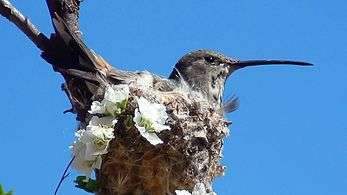 Incubating in Copiapó, Chile
Incubating in Copiapó, Chile Nest with two nestlings in Santa Monica, California
Nest with two nestlings in Santa Monica, California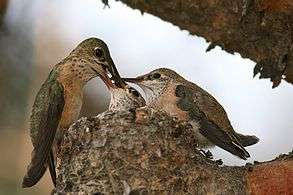 Feeding two nestlings in Grand Teton National Park
Feeding two nestlings in Grand Teton National Park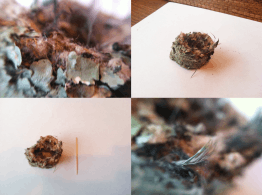
Feather colors
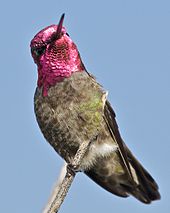
To serve courtship and territorial competition, many male hummingbirds have plumage with bright, varied coloration[76] resulting both from pigmentation in the feathers and from prismal cells within the top layers of feathers of the head, gorget, breast, back and wings.[77] When sunlight hits these cells, it is split into wavelengths that reflect to the observer in varying degrees of intensity,[77] with the feather structure acting as a diffraction grating.[77] Iridescent hummingbird colors result from a combination of refraction and pigmentation, since the diffraction structures themselves are made of melanin, a pigment,[76] and may also be colored by carotenoid pigmentation and more subdued black, brown or gray colors dependent on melanin.[77]
By merely shifting position, feather regions of a muted-looking bird can instantly become fiery red or vivid green.[77] In courtship displays for one example, males of the colorful Anna's hummingbird orient their bodies and feathers toward the sun to enhance the display value of iridescent plumage toward a female of interest.[78]
One study of Anna's hummingbirds found that dietary protein was an influential factor in feather color, as birds receiving more protein grew significantly more colorful crown feathers than those fed a low-protein diet.[79] Additionally, birds on a high-protein diet grew yellower (higher hue) green tail feathers than birds on a low-protein diet.[79]
Aerodynamics of flight
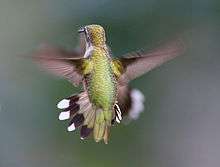
Hummingbird flight has been studied intensively from an aerodynamic perspective using wind tunnels and high-speed video cameras.
Two studies of rufous or Anna's hummingbirds in a wind tunnel used particle image velocimetry techniques to investigate the lift generated on the bird's upstroke and downstroke.[81][82] The birds produced 75% of their weight support during the downstroke and 25% during the upstroke, with the wings making a "figure 8" motion.[83]
Many earlier studies had assumed that lift was generated equally during the two phases of the wingbeat cycle, as is the case of insects of a similar size.[81] This finding shows that hummingbird hovering is similar to, but distinct from, that of hovering insects such as the hawk moth.[81] Further studies using electromyography in hovering rufous hummingbirds showed that muscle strain in the pectoralis major (principal downstroke muscle) was the lowest yet recorded in a flying bird, and the primary upstroke muscle (supracoracoideus) is proportionately larger than in other bird species.[84]
Because of their flying technique, these birds no longer have an alula, while the alula digit has evolved to become absent.[85]
The giant hummingbird's wings beat as few as 12 beats per second[86] and the wings of typical hummingbirds beat up to 80 times per second.[87]
A slow-motion video has shown how the hummingbirds deal with rain when they are flying. To remove the water from their heads, they shake their heads and bodies, similar to a dog shaking, to shed water.[88] Further, when raindrops collectively may weigh as much as 38% of the bird's body weight, hummingbirds shift their bodies and tails horizontally, beat their wings faster, and reduce their wings' angle of motion when flying in heavy rain.[89]

Feather sonation
Courtship dives
When courting, the male Anna's hummingbird ascends some 35 meters before diving over an interested female at a speed of 27 m/s, equal to 385 body lengths/second, producing a high-pitched sound.[90] This downward acceleration during a dive is the highest reported for any vertebrate undergoing a voluntary aerial maneuver; in addition to acceleration, the speed, relative to body length, is the highest known for any vertebrate. For instance, it is about twice the diving speed of peregrine falcons in pursuit of prey.[90] At maximum descent speed, about 10 g of gravitational force occurs in the courting hummingbird during a dive.[90] By comparison to humans, this is a g-force acceleration causing near loss of consciousness in fighter pilots during flight of fixed-wing aircraft in a high-speed banked turn.[90][91]
The outer tail feathers of male Anna's (Calypte anna) and Selasphorus hummingbirds (e.g., Allen's, calliope) vibrate during courtship display dives and produce an audible chirp caused by aeroelastic flutter.[92][93] Hummingbirds cannot make the courtship dive sound when missing their outer tail feathers, and those same feathers could produce the dive-sound in a wind tunnel.[92] The bird can sing at the same frequency as the tail feather chirp, but its small syrinx is not capable of the same volume.[94] The sound is caused by the aerodynamics of rapid air flow past tail feathers, causing them to flutter in a vibration which produces the high-pitched sound of a courtship dive.[92][95]
Many other species of hummingbirds also produce sounds with their wings or tails while flying, hovering or diving, including the wings of the calliope hummingbird,[96] broad-tailed hummingbird, rufous hummingbird, Allen's hummingbird, and streamertail, as well as the tail of the Costa's hummingbird and the black-chinned hummingbird, and a number of related species.[97] The harmonics of sounds during courtship dives vary across species of hummingbirds.[93]
Wing feather trill
Male rufous and broad-tailed hummingbirds (genus Selasphorus) have a distinctive wing feature during normal flight that sounds like jingling or a buzzing shrill whistle.[98] The trill arises from air rushing through slots created by the tapered tips of the ninth and tenth primary wing feathers, creating a sound loud enough to be detected by female or competitive male hummingbirds and researchers up to 100 m away.[98]
Behaviorally, the trill serves several purposes:[98]
- Announces the sex and presence of a male bird
- Provides audible aggressive defense of a feeding territory and an intrusion tactic
- Enhances communication of a threat
- Favors mate attraction and courtship
Range
Hummingbirds are restricted to the Americas from south central Alaska to Tierra del Fuego, including the Caribbean. The majority of species occur in tropical and subtropical Central and South America, but several species also breed in temperate climates and some hillstars occur even in alpine Andean highlands at altitudes up to 5,200 metres (17,100 ft).[99]
The greatest species richness is in humid tropical and subtropical forests of the northern Andes and adjacent foothills, but the number of species found in the Atlantic Forest, Central America or southern Mexico also far exceeds the number found in southern South America, the Caribbean islands, the United States, and Canada. While fewer than 25 different species of hummingbirds have been recorded from the United States and fewer than 10 from Canada and Chile each,[100] Colombia alone has more than 160[101] and the comparably small Ecuador has about 130 species.[102]
The migratory ruby-throated hummingbird breeds in a range from the southeastern United States to Ontario,[103] while the black-chinned hummingbird, its close relative and another migrant, is the most widespread and common species in the southwestern United States. The rufous hummingbird is the most widespread species in western North America,[104] and the only hummingbird to be recorded outside of the Americas, having occurred in the Chukchi Peninsula of Russia.[105]
Migration
Most North American hummingbirds migrate southward in fall to spend winter in Mexico, the Caribbean Islands, or Central America.[106] A few southern South American species also move north to the tropics during the southern winter. A few species are year-round residents of Florida, California, and the far southwestern desert regions of the US.[106] Among these are Anna's hummingbird, a common resident from southern Arizona and inland California, and the buff-bellied hummingbird, a winter resident from Florida across the Gulf Coast to southern Texas. Ruby-throated hummingbirds are common along the Atlantic flyway and migrate in summer from as far north as Atlantic Canada,[106] returning to Mexico, South America, southern Texas, and Florida to winter.[106][107] During winter months in southern Louisiana, black-chinned, buff-bellied, calliope, Allen's, Anna's, ruby-throated, rufous, broad-tailed, and broad-billed hummingbirds are present.[106]
The rufous hummingbird breeds farther north than any other species of hummingbird,[106] often breeding in large numbers in temperate North America and wintering in increasing numbers along the coasts of the subtropical Gulf of Mexico and Florida, rather than in western or central Mexico.[108] By migrating in spring as far north as the Yukon or southern Alaska,[106][108] the rufous hummingbird migrates more extensively and nests farther north than any other hummingbird species, and must tolerate occasional temperatures below freezing in its breeding territory. This cold hardiness enables it to survive temperatures below freezing, provided that adequate shelter and food are available.[108]
As calculated by displacement of body size, the rufous hummingbird makes perhaps the longest migratory journey of any bird in the world. At just over 3 in long, rufous birds travel 3,900 miles one-way from Alaska to Mexico in late summer, a distance equal to 78,470,000 body lengths.[108] By comparison, the 13-inch-long Arctic tern makes a one-way flight of about 11,185 miles, or 51,430,000 body lengths, just 65% of the body displacement during migration by rufous hummingbirds.[108]
The northward migration of rufous hummingbirds occurs along the Pacific flyway[108] and may be time-coordinated with flower and tree leaf emergence in spring in early March, and also with availability of insects as food.[109] Arrival at breeding grounds before nectar availability from mature flowers may jeopardize breeding opportunities.[110]
Diet and specializations for food gathering
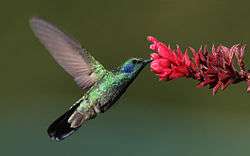
For nutrition, hummingbirds eat a variety of insects, including mosquitoes, fruit flies, gnats in flight or aphids on leaves and spiders in their webs.[111][112][113][114] The lower beak of hummingbirds is flexible and can bend as much as 25 degrees when it widens at the base, making a larger surface for catching insects.[113] Hummingbirds hover within insect swarms in a method called "hover-hawking" to facilitate feeding.[114]
To supply energy needs, hummingbirds drink nectar, a sweet liquid inside certain flowers. Like bees, they are able to assess the amount of sugar in the nectar they drink; they normally reject flower types that produce nectar that is less than 10% sugar and prefer those whose sugar content is higher. Nectar is a mixture of glucose, fructose, and sucrose, and is a poor source of nutrients, requiring hummingbirds to meet their nutritional needs by consuming insects.[113][114]
Hummingbirds do not spend all day flying, as the energy cost would be prohibitive; the majority of their activity consists simply of sitting or perching. Hummingbirds eat many small meals and consume around half their weight in nectar (twice their weight in nectar, if the nectar is 25% sugar) each day.[115] Hummingbirds digest their food rapidly due to their small size and high metabolism; a mean retention time less than an hour has been reported.[116] Hummingbirds spend an average of 10–15% of their time feeding and 75–80% sitting and digesting.
Because their high metabolism makes them vulnerable to starvation, hummingbirds are highly attuned to food sources. Some species, including many found in North America, are territorial and will try to guard food sources (such as a feeder) against other hummingbirds, attempting to ensure a future food supply for itself. Additionally, hummingbirds have an enlarged hippocampus, a brain region facilitating spatial memory used to map flowers previously visited during nectar foraging.[117]
Hummingbird beaks are flexible[113] and their shapes vary dramatically as an adaptation for specialized feeding.[15][16] Some species, such as hermits (Phaethornis spp.) have long bills that allow them to probe deep into flowers with long corollae. Thornbills have short, sharp bills adapted for feeding from flowers with short corollae and piercing the bases of longer ones. The sicklebills' extremely decurved bills are adapted to extracting nectar from the curved corollae of flowers in the family Gesneriaceae. The bill of the fiery-tailed awlbill has an upturned tip, as in the avocets. The male tooth-billed hummingbird has barracudalike spikes at the tip of its long, straight bill.
The two halves of a hummingbird's bill have a pronounced overlap, with the lower half (mandible) fitting tightly inside the upper half (maxilla). When a hummingbird feeds on nectar, the bill is usually opened only slightly, allowing the tongue to dart out and into the interior of flowers. Hummingbird bill sizes range from about 5 mm to as long as 100 mm (about 4 in).[118] When catching insects in flight, a hummingbird's jaw flexes downward to widen the gape for successful capture.[112]
Perception of sweet nectar
Perception of sweetness in nectar evolved in hummingbirds during their genetic divergence from insectivorous swifts, their closest bird relatives.[119] Although the only known sweet sensory receptor, called T1R2,[120] is absent in birds, receptor expression studies showed that hummingbirds adapted a carbohydrate receptor from the T1R1-T1R3 receptor, identical to the one perceived as umami in humans, essentially repurposing it to function as a nectar sweetness receptor.[119] This adaptation for taste enabled hummingbirds to detect and exploit sweet nectar as an energy source, facilitating their distribution across geographical regions where nectar-bearing flowers are available.[119]
Tongue as a micropump
Hummingbirds drink with their long tongues by rapidly lapping nectar. Their tongues have tubes which run down their lengths and help the hummingbirds drink the nectar.[121] While capillary action was believed to be what drew nectar into these tubes, high-speed photography has revealed that the tubes open down their sides as the tongue goes into the nectar, and then close around the nectar, trapping it so it can be pulled back into the beak.[122][123] The tongue, which is forked, is compressed until it reaches nectar, then the tongue springs open, the rapid action traps the nectar and the nectar moves up the grooves, like a pump action, with capillary action not involved.[121][124] Consequently, tongue flexibility enables accessing, transporting and unloading nectar.[125][126]
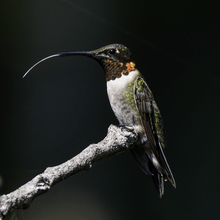
Feeders and artificial nectar
In the wild, hummingbirds visit flowers for food, extracting nectar, which is 55% sucrose, 24% glucose and 21% fructose on a dry-matter basis.[127] Hummingbirds also take sugar-water from bird feeders. Such feeders allow people to observe and enjoy hummingbirds up close while providing the birds with a reliable source of energy, especially when flower blossoms are less abundant. A negative aspect of artificial feeders, however, is that the birds may seek less flower nectar for food, so they reduce the amount of pollination their feeding naturally provides.[128]
White granulated sugar is the best sweetener to use in hummingbird feeders. A ratio of 1 part sugar to 4 parts water, or 25% concentration, is a common recipe,[129] although hummingbirds will defend feeders more aggressively when sugar content is at 35%, indicating preference for nectar with higher sweetness and sugar content.[130] Organic and "raw" sugars contain iron, which can be harmful,[131] and brown sugar agave syrup, molasses and artificial sweeteners also should not be used.[132] Honey is made by bees from the nectar of flowers, but it is not good to use in feeders because when it is diluted with water, microorganisms easily grow in it, causing it to spoil rapidly.[133][134][135]
Red food dye was once thought to be a favorable ingredient for homemade solutions, but it is unnecessary, and there is no point in adding it to the nectar. Some people speculate red dye could be bad for the birds, although this claim has not received scientific attention.[136] Commercial products sold as "instant nectar" or "hummingbird food" may also contain preservatives and/or artificial flavors as well as dyes, and are not necessary,[136] although the long-term effects of these additives on hummingbirds have not been systematically studied.[137] Although some commercial products contain small amounts of nutritional additives, hummingbirds obtain all necessary nutrients from the insects they eat, rendering added nutrients unnecessary.[104]
Other animals also visit hummingbird feeders. Bees, wasps, and ants are attracted to the sugar-water and may crawl into the feeder, where they may become trapped and drown. Orioles, woodpeckers, bananaquits, raccoons and other larger animals are known to drink from hummingbird feeders, sometimes tipping them and draining the liquid.[138] In the southwestern United States, two species of nectar-drinking bats (Leptonycteris yerbabuenae and Choeronycteris mexicana) visit hummingbird feeders to supplement their natural diet of nectar and pollen from saguaro cacti and agaves.[139]

Visual cues of foraging
Hummingbirds have exceptional visual acuity providing them with discrimination of food sources while foraging.[34] Although it is commonly believed that hummingbirds are attracted to color while seeking food, such as red flowers or artificial feeders, experiments indicate that location and flower nectar quality are the most important "beacons" for foraging.[140][141] Hummingbirds depended little on visual cues of flower color to beacon to nectar-rich locations, but rather they used surrounding landmarks to find the nectar reward.[142][143]
In at least one hummingbird species – the green-backed firecrown (Sephanoides sephaniodes) – flower colors preferred are in the red-green wavelength for the bird's visual system, providing a higher contrast than for other flower colors.[144] Further, the crown plumage of firecrown males is highly iridescent in the red wavelength range (peak at 650 nanometers), possibly providing a competitive advantage of dominance when foraging among other hummingbird species with less colorful plumage.[144] The ability to discriminate colors of flowers and plumage is enabled by a visual system having four single cone cells and a double cone screened by photoreceptor oil droplets which enhance color discrimination.[140][144]
Superficially similar species
Some species of sunbirds of Africa, southern and southeastern Asia, and Australia resemble hummingbirds in appearance and behavior, as do perhaps also the honeyeaters of Australia and Pacific islands. These two groups, however, are not related to hummingbirds, as their resemblance is due to convergent evolution.[145]
The hummingbird moth is often mistaken for a hummingbird.
In myth and culture
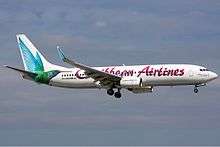
- Aztecs wore hummingbird talismans, both artistic representations of hummingbirds and fetishes made from actual hummingbird parts: emblematic for their vigor, energy, and propensity to do work along with their sharp beaks that symbolically mimic instruments of weaponry, bloodletting, penetration, and intimacy. Hummingbird talismans were prized as drawing sexual potency, energy, vigor, and skill at arms and warfare to the wearer.[146]
- The Aztec god of war Huitzilopochtli is often depicted as a hummingbird. It was also believed that fallen warriors would return to earth as hummingbirds and butterflies.[147] The Nahuatl word huitzil (hummingbird) is an onomatopoeic word derived from the sounds of the hummingbird's wing-beats and zooming flight.
- One of the Nazca Lines depicts a hummingbird (right).
- In Hopi and Zuni culture, there is a hummingbird creation myth about a young brother and sister who are starving because drought and famine have come to the land. Their parents have left to find food, so the boy carves a piece of wood into a small bird to entertain his sister. When the girl tosses the carving into the air, the bird comes to life, turning into a hummingbird. The small bird then flies to the God of Fertility and begs for rain, and the god obliges the request, which helps the crops to grow again.[148]
- Trinidad and Tobago, known as "The land of the hummingbird," displays a hummingbird on that nation's coat of arms,[149] 1-cent coin[150] and emblem of its national airline, Caribbean Airlines (right).
Gallery
 Hummingbird feeding from a flower in the University of California Botanical Garden
Hummingbird feeding from a flower in the University of California Botanical Garden Hummingbird with yellow pollen on its beak in the University of California Botanical Garden
Hummingbird with yellow pollen on its beak in the University of California Botanical Garden

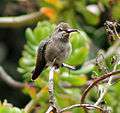 Juvenile Anna's hummingbird with tongue sticking out
Juvenile Anna's hummingbird with tongue sticking out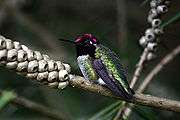 Calypte anna perched
Calypte anna perched Hummingbird chicks in a nest in a cactus in Mesa, Arizona
Hummingbird chicks in a nest in a cactus in Mesa, Arizona Hummingbird adult in its nest in a cactus in Mesa, Arizona
Hummingbird adult in its nest in a cactus in Mesa, Arizona- A female Anna's Hummingbird perched on a small branch.
See also
- AeroVironment Nano Hummingbird – artificial hummingbird
- Macroglossum stellatarum – hummingbird hawk-moth
- Hemaris – sphinx moths (hummingbird moths) confused with hummingbirds
References
- Clark, C. J.; Dudley, R. (2009). "Flight costs of long, sexually selected tails in hummingbirds". Proceedings of the Royal Society B: Biological Sciences. 276 (1664): 2109–15. doi:10.1098/rspb.2009.0090. PMC 2677254. PMID 19324747.
- Ridgely RS, Greenfield PG (2001). The Birds of Ecuador, Field Guide (1 ed.). Cornell University Press. ISBN 978-0-8014-8721-7.
- Suarez, R. K. (1992). "Hummingbird flight: Sustaining the highest mass-specific metabolic rates among vertebrates". Experientia. 48 (6): 565–70. doi:10.1007/bf01920240. PMID 1612136.
- "Hummingbirds". Nationalzoo.si.edu. Archived from the original on 2012-07-16. Retrieved 2013-04-01.
- "Hummingbirds' 22-million-year-old history of remarkable change is far from complete". ScienceDaily. 3 April 2014. Retrieved 30 September 2014.
- McGuire, Jimmy A.; Witt, Christopher C.; Altshuler, Douglas L.; Remsen, J. V. (2007-10-01). "Phylogenetic Systematics and Biogeography of Hummingbirds: Bayesian and Maximum Likelihood Analyses of Partitioned Data and Selection of an Appropriate Partitioning Strategy". Systematic Biology. 56 (5): 837–56. doi:10.1080/10635150701656360. ISSN 1063-5157. PMID 17934998.
- McGuire, Jimmy A.; Witt, Christopher C.; Remsen, J. V.; Corl, Ammon; Rabosky, Daniel L.; Altshuler, Douglas L.; Dudley, Robert (Apr 2014). "Molecular Phylogenetics and the Diversification of Hummingbirds". Current Biology. 24 (8): 910–16. doi:10.1016/j.cub.2014.03.016. ISSN 0960-9822. PMID 24704078.
- McGuire, Jimmy A.; Witt, Christopher C.; Jr, J. V. Remsen; Dudley, R.; Altshuler, Douglas L. (2008-08-05). "A higher-level taxonomy for hummingbirds". Journal of Ornithology. 150 (1): 155–65. doi:10.1007/s10336-008-0330-x. ISSN 0021-8375.
- Baldwin, M. W.; Toda, Y.; Nakagita, T.; O'Connell, M. J.; Klasing, K. C.; Misaka, T.; Edwards, S. V.; Liberles, S. D. (2014). "Evolution of sweet taste perception in hummingbirds by transformation of the ancestral umami receptor". Science. 345 (6199): 929–33. Bibcode:2014Sci...345..929B. doi:10.1126/science.1255097. PMC 4302410. PMID 25146290.
- Abrahamczyk S, Renner SS (2015). "The temporal build-up of hummingbird/plant mutualisms in North America and temperate South America". BMC Evolutionary Biology. 15: 104. doi:10.1186/s12862-015-0388-z. PMC 4460853. PMID 26058608.
- Abrahamczyk S, Souto-Vilarós D, McGuire JA, Renner SS (2015). "Diversity and clade ages of West Indian hummingbirds and the largest plant clades dependent on them: a 5–9 Myr young mutualistic system". Biological Journal of the Linnean Society. 114 (4): 848–59. doi:10.1111/bij.12476.
- Abrahamczyk, S.; Souto-Vilaros, D.; Renner, S. S. (2014). "Escape from extreme specialization: Passionflowers, bats and the sword-billed hummingbird". Proceedings of the Royal Society B: Biological Sciences. 281 (1795): 20140888. doi:10.1098/rspb.2014.0888. PMC 4213610. PMID 25274372.
- Colwell, Robert K. (2000-11-01). "Rensch's Rule Crosses the Line: Convergent Allometry of Sexual Size Dimorphism in Hummingbirds and Flower Mites". The American Naturalist. 156 (5): 495–510. doi:10.1086/303406. JSTOR 303406. PMID 29587514.
- Lisle, Stephen P. De; Rowe, Locke (2013-11-01). "Correlated Evolution of Allometry and Sexual Dimorphism across Higher Taxa". The American Naturalist. 182 (5): 630–39. doi:10.1086/673282. JSTOR 673282. PMID 24107370.
- Berns, Chelsea M.; Adams, Dean C. (2012-11-11). "Becoming Different But Staying Alike: Patterns of Sexual Size and Shape Dimorphism in Bills of Hummingbirds". Evolutionary Biology. 40 (2): 246–60. doi:10.1007/s11692-012-9206-3. ISSN 0071-3260.
- Temeles, Ethan J.; Miller, Jill S.; Rifkin, Joanna L. (2010-04-12). "Evolution of sexual dimorphism in bill size and shape of hermit hummingbirds (Phaethornithinae): a role for ecological causation". Philosophical Transactions of the Royal Society of London B: Biological Sciences. 365 (1543): 1053–63. doi:10.1098/rstb.2009.0284. ISSN 0962-8436. PMC 2830232. PMID 20194168.
- Stiles, Gary (1981). "Geographical Aspects of Bird Flower Coevolution, with Particular Reference to Central America" (PDF). Annals of the Missouri Botanical Garden. 68 (2): 323–51. doi:10.2307/2398801. JSTOR 2398801.
- Maglianesi, M. A., Blüthgen, N., Böhning-Gaese, K. & Schleuning, M. (2014). Morphological traits determine specialization and resource use in plant–hummingbird networks in the neotropics. Ecology, 95(12), 3325-3334.
- Abrahamczyk, S., Poretschkin, C., & Renner, S. S. (2017). "Evolutionary flexibility in five hummingbird/plant mutualistic systems: testing temporal and geographic matching". Journal of Biogeography. 44 (8): 1847–55. doi:10.1111/jbi.12962.CS1 maint: multiple names: authors list (link)
- Simon, Matt (10 July 2015). "Absurd Creature of the Week: The World's Tiniest Bird Weighs Less Than a Dime". Wired. Retrieved 8 March 2017.
- Dalsgaard, B; Martín González, A. M.; Olesen, J. M.; Ollerton, J; Timmermann, A; Andersen, L. H.; Tossas, A. G. (2009). "Plant-hummingbird interactions in the West Indies: Floral specialisation gradients associated with environment and hummingbird size". Oecologia. 159 (4): 757–66. Bibcode:2009Oecol.159..757D. doi:10.1007/s00442-008-1255-z. PMID 19132403.
- Rodríguez-Gironés, M. A.; Santamaría, L. (2004). "Why Are So Many Bird Flowers Red?". PLoS Biol. 2 (10): e350. doi:10.1371/journal.pbio.0020350. PMC 521733. PMID 15486585.
- Altschuler, D. L. (2003). "Flower Color, Hummingbird Pollination, and Habitat Irradiance in Four Neotropical Forests". Biotropica. 35 (3): 344–55. doi:10.1646/02113. JSTOR 30043050.
- Nicolson, S. W. & Fleming, P. A. (2003). "Nectar as food for birds: the physiological consequences of drinking dilute sugar solutions". Plant Syst. Evol. 238 (1–4): 139–53. doi:10.1007/s00606-003-0276-7.
- Rico-Guevara A, Araya-Salas M (2015). "Bills as daggers? A test for sexually dimorphic weapons in a lekking hummingbird". Behavioral Ecology. 26 (1): 21–29. doi:10.1093/beheco/aru182.
- Mayr, Gerald (March 2005). "Fossil Hummingbirds of the Old World" (PDF). Biologist. 52 (1): 12–16. Archived from the original (PDF) on 2011-09-27. Retrieved 2009-12-14.
- "Oldest hummingbird fossil found". Cbc.ca. 2004-05-06. Retrieved 2009-01-25.
- Bleiweiss, Robert; Kirsch, John A. W.; Matheus, Juan Carlos (1999). "DNA-DNA hybridization evidence for subfamily structure among hummingbirds" (PDF). Auk. 111 (1): 8–19. doi:10.2307/4088500. JSTOR 4088500.
- Ksepka, Daniel T.; Clarke, Julia A.; Nesbitt, Sterling J.; Kulp, Felicia B.; Grande, Lance (2013). "Fossil evidence of wing shape in a stem relative of swifts and hummingbirds (Aves, Pan-Apodiformes)". Proceedings of the Royal Society B. 280 (1761): 1761. doi:10.1098/rspb.2013.0580. PMC 3652446. PMID 23760643.
- Steen, Ronny; Kagge, Erik Olfert; Lilleengen, Petter; Lindemann, Jon Peder; Midtgaard, Fred (2020). "Wingbeat frequencies in free-ranging hummingbirds in Costa Rica and Ecuador". Cotinga. 42: 3–8.
- Clark, C. J. (2011). "Wing, tail, and vocal contributions to the complex acoustic signals of courting Calliope hummingbirds". Current Zool. 57: 187–196.
- Ravi S, Crall JD, McNeilly L, Gagliardi SF, Biewener AA, Combes SA (2015). "Hummingbird flight stability and control in freestream turbulent winds". J Exp Biol. 218 (Pt 9): 1444–52. doi:10.1242/jeb.114553. PMID 25767146.
- Goller B, Altshuler DL (2014). "Hummingbirds control hovering flight by stabilizing visual motion". Proceedings of the National Academy of Sciences. 111 (51): 18375–80. Bibcode:2014PNAS..11118375G. doi:10.1073/pnas.1415975111. PMC 4280641. PMID 25489117.
- Lisney TJ, Wylie DR, Kolominsky J, Iwaniuk AN (2015). "Eye morphology and retinal topography in hummingbirds (Trochilidae Aves)". Brain Behav Evol. 86 (3–4): 176–90. doi:10.1159/000441834. PMID 26587582.
- Iwaniuk AN, Wylie DR (2007). "Neural specialization for hovering in hummingbirds: hypertrophy of the pretectal nucleus Lentiformis mesencephali" (PDF). J Comp Neurol. 500 (2): 211–21. doi:10.1002/cne.21098. PMID 17111358.
- Gaede, A. H.; Goller, B; Lam, J. P.; Wylie, D. R.; Altshuler, D. L. (2017). "Neurons responsive to global visual motion have unique tuning properties in hummingbirds". Current Biology. 27 (2): 279–285. doi:10.1016/j.cub.2016.11.041. PMID 28065606.
- "Hummingbirds see motion in an unexpected way". ScienceDaily. 5 January 2017. Retrieved 24 April 2017.
- Stoddard, Mary Caswell; Eyster, Harold N.; Hogan, Benedict G.; Morris, Dylan H.; Soucy, Edward R.; Inouye, David W (2020-06-15). "Wild hummingbirds discriminate nonspectral colors". Proceedings of the National Academy of Sciences: 201919377. doi:10.1073/pnas.1919377117. ISSN 0027-8424. PMID 32541035.CS1 maint: uses authors parameter (link)
- Altshuler, D. L.; Dudley, R (2002). "The ecological and evolutionary interface of hummingbird flight physiology". The Journal of Experimental Biology. 205 (Pt 16): 2325–36. PMID 12124359.
- Lasiewski, Robert C. (1964). "Body temperatures, heart and breathing rate, and evaporative water loss in hummingbirds". Physiological Zoology. 37 (2): 212–223. doi:10.1086/physzool.37.2.30152332.
- Hargrove, J. L. (2005). "Adipose energy stores, physical work, and the metabolic syndrome: Lessons from hummingbirds". Nutrition Journal. 4: 36. doi:10.1186/1475-2891-4-36. PMC 1325055. PMID 16351726.
- Welch Jr, K. C.; Chen, C. C. (2014). "Sugar flux through the flight muscles of hovering vertebrate nectarivores: A review". Journal of Comparative Physiology B. 184 (8): 945–59. doi:10.1007/s00360-014-0843-y. PMID 25031038.
- Chen, Chris Chin Wah; Welch, Kenneth Collins (2014). "Hummingbirds can fuel expensive hovering flight completely with either exogenous glucose or fructose". Functional Ecology. 28 (3): 589–600. doi:10.1111/1365-2435.12202.
- Welch Jr, K. C.; Suarez, R. K. (2007). "Oxidation rate and turnover of ingested sugar in hovering Anna's (Calypte anna) and rufous (Selasphorus rufus) hummingbirds". Journal of Experimental Biology. 210 (Pt 12): 2154–62. doi:10.1242/jeb.005363. PMID 17562889.
- Suarez, Raul; Welch, Kenneth (12 July 2017). "Sugar metabolism in hummingbirds and nectar bats". Nutrients. 9 (7): 743. doi:10.3390/nu9070743. ISSN 2072-6643. PMC 5537857. PMID 28704953.
- Skutch, Alexander F. & Singer, Arthur B. (1973). The Life of the Hummingbird. New York: Crown Publishers. ISBN 978-0-517-50572-4.
- Powers, Donald R.; Langland, Kathleen M.; Wethington, Susan M.; Powers, Sean D.; Graham, Catherine H.; Tobalske, Bret W. (2017). "Hovering in the heat: effects of environmental temperature on heat regulation in foraging hummingbirds". Royal Society Open Science. 4 (12): 171056. doi:10.1098/rsos.171056. ISSN 2054-5703. PMC 5750011. PMID 29308244.
- Evangelista, Dennis; Fernández, María José; Berns, Madalyn S.; Hoover, Aaron; Dudley, Robert (2010). "Hovering energetics and thermal balance in Anna's hummingbirds (Calypte anna)". Physiological and Biochemical Zoology. 83 (3): 406–413. doi:10.1086/651460. ISSN 1522-2152. PMID 20350142.
- Matt Soniak (2 February 2016). "Infrared video shows how hummingbirds shed heat through their eyes and feet". Mental Floss. Retrieved 14 January 2020.
- Miklos D F Udvardy (1983). "The role of the feet in behavioral thermoregulation of hummingbirds" (PDF). Condor. 85: 281–5.
- Suarez, R. K.; Gass, C. L. (2002). "Hummingbirds foraging and the relation between bioenergetics and behavior". Comparative Biochemistry and Physiology. Part A. 133 (2): 335–343. doi:10.1016/S1095-6433(02)00165-4. PMID 12208304.
- Bakken, B. H.; McWhorter, T. J.; Tsahar, E.; Martinez del Rio, C. (2004). "Hummingbirds arrest their kidneys at night: diel variation in glomerular filtration rate in Selasphorus platycercus". The Journal of Experimental Biology. 207 (25): 4383–4391. doi:10.1242/jeb.01238. PMID 15557024.
- Bakken, BH; Sabat, P (2006). "Gastrointestinal and renal responses to water intake in the green-backed firecrown (Sephanoides sephanoides), a South American hummingbird". AJP: Regulatory, Integrative and Comparative Physiology. 291 (3): R830–6. doi:10.1152/ajpregu.00137.2006. PMID 16614056.
- Lotz, Chris N.; Martínez Del Rio, Carlos (2004). "The ability of rufous hummingbirds Selasphorus rufus to dilute and concentrate urine". Journal of Avian Biology. 35: 54–62. doi:10.1111/j.0908-8857.2004.03083.x.
- Beuchat CA, Preest MR, Braun EJ (1999). "Glomerular and medullary architecture in the kidney of Anna's Hummingbird". Journal of Morphology. 240 (2): 95–100. doi:10.1002/(sici)1097-4687(199905)240:2<95::aid-jmor1>3.0.co;2-u. PMID 29847878.
- "Song sounds of various hummingbird species". All About Birds. The Cornell Lab of Ornithology, Cornell University, Ithaca, NY. 2015. Retrieved 25 June 2016.
- Jarvis ED, Ribeiro S, da Silva ML, Ventura D, Vielliard J, Mello CV (2000). "Behaviourally driven gene expression reveals song nuclei in hummingbird brain". Nature. 406 (6796): 628–32. Bibcode:2000Natur.406..628J. doi:10.1038/35020570. PMC 2531203. PMID 10949303.
- Gahr M (2000). "Neural song control system of hummingbirds: comparison to swifts, vocal learning (Songbirds) and nonlearning (Suboscines) passerines, and vocal learning (Budgerigars) and nonlearning (Dove, owl, gull, quail, chicken) nonpasserines". J Comp Neurol. 426 (2): 182–96. doi:10.1002/1096-9861(20001016)426:2<182::AID-CNE2>3.0.CO;2-M. PMID 10982462.
- Renne, Paul R.; Deino, Alan L.; Hilgen, Frederik J.; Kuiper, Klaudia F.; Mark, Darren F.; Mitchell, William S.; Morgan, Leah E.; Mundil, Roland; Smit, Jan (7 February 2013). "Time Scales of Critical Events Around the Cretaceous-Paleogene Boundary" (PDF). Science. 339 (6120): 684–687. Bibcode:2013Sci...339..684R. doi:10.1126/science.1230492. PMID 23393261.
- Pytte, C. L.; Ficken, M. S.; Moiseff, A (2004). "Ultrasonic singing by the blue-throated hummingbird: A comparison between production and perception". Journal of Comparative Physiology A. 190 (8): 665–73. doi:10.1007/s00359-004-0525-4. PMID 15164219.
- Hainsworth, F. R.; Wolf, L. L. (1970). "Regulation of oxygen consumption and body temperature during torpor in a hummingbird, Eulampis jugularis". Science. 168 (3929): 368–9. Bibcode:1970Sci...168..368R. doi:10.1126/science.168.3929.368. PMID 5435893.
- Hiebert, S. M. (1992). "Time-dependent thresholds for torpor initiation in the rufous hummingbird (Selasphorus rufus)". Journal of Comparative Physiology B. 162 (3): 249–55. doi:10.1007/bf00357531. PMID 1613163.
- Hiebert, S. M.; Salvante, K. G.; Ramenofsky, M; Wingfield, J. C. (2000). "Corticosterone and nocturnal torpor in the rufous hummingbird (Selasphorus rufus)". General and Comparative Endocrinology. 120 (2): 220–34. doi:10.1006/gcen.2000.7555. PMID 11078633.
- Powers, D. R.; Brown, A. R.; Van Hook, J. A. (2003). "Influence of normal daytime fat deposition on laboratory measurements of torpor use in territorial versus nonterritorial hummingbirds". Physiological and Biochemical Zoology. 76 (3): 389–97. doi:10.1086/374286. PMID 12905125.
- "The hummingbird project of British Columbia". Rocky Point Bird Observatory, Vancouver Island, British Columbia. 2010. Retrieved 25 June 2016.
- Churchfield, Sara. (1990). The natural history of shrews. Cornell University Press. pp. 35–37. ISBN 978-0-8014-2595-0.
- Patuxent Wildlife Research Center, Bird Banding Laboratory. Longevity Records AOU Numbers 3930–4920 2009-08-31. Retrieved 2009-09-27.
- Valdez, Jose W. "Arthropods as vertebrate predators: A review of global patterns". Global Ecology and Biogeography. n/a (n/a). doi:10.1111/geb.13157. ISSN 1466-8238.
- Fisher Jr,, R. (1994). "Praying mantis catches and eats hummingbird". Birding. 26: 376.CS1 maint: extra punctuation (link)
- Lorenz, S. (2007). "Carolina mantid (Stagmomantis carolina) captures and feeds on a Broad-tailed Hummingbird (Selasphorus platycercus)". Bulletin of the Texas ornithological Society. 40: 37–38.
- Oniki, Y; Willis, E. O. (2000). "Nesting behavior of the swallow-tailed hummingbird, Eupetomena macroura (Trochilidae, Aves)". Brazilian Journal of Biology = Revista Brasleira de Biologia. 60 (4): 655–62. doi:10.1590/s0034-71082000000400016. PMID 11241965.
- "Hummingbird nesting". Public Broadcasting System – Nature; from Learner.org, Journey North. 2016. Archived from the original (video) on 2 February 2017. Retrieved 12 May 2016.
- "Hummingbird nesting and fledgling" (video). 2011. Retrieved 12 May 2016 – via YouTube.
- "Hummingbird Q&A: Nest and eggs". Operation Rubythroat: the Hummingbird Project, Hilton Pond Center for Piedmont Natural History. 2014. Retrieved 21 June 2014.
- Mohrman, Eric (22 November 2019). "How do hummingbirds mate?". Sciencing, Leaf Group Media. Retrieved 8 February 2020.
- "Hummingbird characteristics". learner.org. Annenberg Learner, The Annenberg Foundation. 2015. Archived from the original on 2016-11-11. Retrieved 2010-08-30.
- Williamson S (2001). A Field Guide to Hummingbirds of North America. Section: Plumage and Molt. Houghton Mifflin Harcourt. pp. 13–18. ISBN 978-0-618-02496-4.
- Hamilton WJ (1965). "Sun-oriented display of the Anna's hummingbird" (PDF). The Wilson Bulletin. 77 (1).
- Meadows MG, Roudybush TE, McGraw KJ (2012). "Dietary protein level affects iridescent coloration in Anna's hummingbirds, Calypte anna". J Exp Biol. 215 (16): 2742–50. doi:10.1242/jeb.069351. PMC 3404802. PMID 22837446.
- Rayner, J.M.V. (1995). "Dynamics of vortex wakes of flying and swimming vertebrates". Symp. Soc. Exp. Biol. 49: 131–55. PMID 8571221.
- Warrick DR, Tobalske BW, Powers DR (2005). "Aerodynamics of the hovering hummingbird". Nature. 435 (7045): 1094–97. Bibcode:2005Natur.435.1094W. doi:10.1038/nature03647. PMID 15973407.
- Sapir, N; Dudley, R (2012). "Backward flight in hummingbirds employs unique kinematic adjustments and entails low metabolic cost". Journal of Experimental Biology. 215 (Pt 20): 3603–11. doi:10.1242/jeb.073114. PMID 23014570.
- Tobalske BW, Warrick DR, Clark CJ, Powers DR, Hedrick TL, Hyder GA, Biewener AA (2007). "Three-dimensional kinematics of hummingbird flight". J Exp Biol. 210 (13): 2368–82. doi:10.1242/jeb.005686. PMID 17575042.
- Tobalske, B. W.; Biewener, A. A.; Warrick, D. R.; Hedrick, T. L.; Powers, D. R. (2010). "Effects of flight speed upon muscle activity in hummingbirds". Journal of Experimental Biology. 213 (Pt 14): 2515–23. doi:10.1242/jeb.043844. PMID 20581281.
- Videler JJ (2005). Avian Flight. Oxford University Press, Ornithology Series. p. 34. ISBN 978-0-19-856603-8.
- Fernández, M. J.; Dudley, R; Bozinovic, F (2011). "Comparative energetics of the giant hummingbird (Patagona gigas)". Physiological and Biochemical Zoology. 84 (3): 333–40. doi:10.1086/660084. PMID 21527824.
- Gill V (30 July 2014). "Hummingbirds edge out helicopters in hover contest". BBC News. Retrieved 1 Sep 2014.
- Morelle R (November 8, 2011). "Hummingbirds shake their heads to deal with rain". BBC News. Retrieved March 22, 2014.
- St. Fleur N (July 20, 2012). "Hummingbird rain trick: New study shows tiny birds alter posture in storms" (video). Huffington Post. Retrieved March 22, 2014.
- Clark, C. J. (2009). "Courtship dives of Anna's hummingbird offer insights into flight performance limits". Proceedings of the Royal Society B: Biological Sciences. 276 (1670): 3047–52. doi:10.1098/rspb.2009.0508. PMC 2817121. PMID 19515669.
- Shender, B. S.; Forster, E. M.; Hrebien, L; Ryoo, H. C.; Cammarota Jr, J. P. (2003). "Acceleration-induced near-loss of consciousness: The "A-LOC" syndrome". Aviation, Space, and Environmental Medicine. 74 (10): 1021–28. PMID 14556561.
- Clark, C. J.; Feo, T. J. (2008). "The Anna's hummingbird chirps with its tail: A new mechanism of sonation in birds". Proceedings of the Royal Society B: Biological Sciences. 275 (1637): 955–62. doi:10.1098/rspb.2007.1619. PMC 2599939. PMID 18230592.
- Clark CJ (2014). "Harmonic hopping, and both punctuated and gradual evolution of acoustic characters in Selasphorus hummingbird tail-feathers". PLOS ONE. 9 (4): e93829. Bibcode:2014PLoSO...993829C. doi:10.1371/journal.pone.0093829. PMC 3983109. PMID 24722049.
- Clark, C. J.; Feo, T. J. (2010). "Why do Calypte hummingbirds "sing" with both their tail and their syrinx? An apparent example of sexual sensory bias". The American Naturalist. 175 (1): 27–37. doi:10.1086/648560. PMID 19916787.
- Clark, C. J.; Elias, D. O.; Prum, R. O. (2013). "Hummingbird feather sounds are produced by aeroelastic flutter, not vortex-induced vibration". Journal of Experimental Biology. 216 (Pt 18): 3395–403. doi:10.1242/jeb.080317. PMID 23737562.
- Clark CJ (2011). "Wing, tail, and vocal contributions to the complex acoustic signals of courting Calliope hummingbirds" (PDF). Current Zoology. 57 (2): 187–96. doi:10.1093/czoolo/57.2.187.
- Kovacevic M (2008-01-30). "Hummingbird sings with its tail feathers". Cosmos Magazine. Archived from the original on 2012-05-03. Retrieved 2013-07-13.
- Miller SJ, Inouye DW (1983). "Roles of the Wing Whistle in the Territorial Behaviour of Male Broad-tailed Hummingbirds (Selasphorus platycercus)". Animal Behaviour. 31 (3): 689–700. doi:10.1016/S0003-3472(83)80224-3. Retrieved 13 July 2014 – via hummingbirds.net.
- Fjeldså, J. & I. Heynen (1999). Genus Oreotrochilus. pp. 623–24 in: del Hoyo, J., A. Elliott, & J. Sargatal. eds. (1999). Handbook of the Birds of the World. Vol. 5. Barn-owls to Hummingbirds. Lynx Edicions, Barcelona. ISBN 84-87334-25-3
- Jaramillo, A. & R. Barros (2010). Species lists of birds for South American countries and territories: Chile.
- Salaman, P., T. Donegan, & D. Caro (2009). Checklist to the Birds of Colombia 2009. Archived 2009-08-24 at the Wayback Machine Conservation Colombiana 8. Fundación ProAves
- Freile, J. (2009). Species lists of birds for South American countries and territories: Ecuador.
- "Ruby-throated hummingbird". The Ontario Hummingbird Project. 2013. Archived from the original on 20 April 2015. Retrieved 3 May 2015.
- Williamson, S. L. (2002). A Field Guide to Hummingbirds of North America (Peterson Field Guide Series). Houghton Mifflin Co., Boston. ISBN 0-618-02496-4
- "Rufous Hummingbird (Selasphorous rufus)". Handbook of the Birds of the World. 2018. Retrieved 5 Feb 2018.
- "Hummingbird Migration". Hummingbird Central. 2018. Retrieved 28 August 2018.
- "Migration and Range Maps". The Ontario Hummingbird Project. 2013. Archived from the original on April 3, 2014. Retrieved March 23, 2014.
- "Rufous Hummingbird". Cornell University Laboratory of Ornithology. 2014. Retrieved 10 April 2014.
- "Hummingbird news: Tracking migration". Journey North, Annenberg Learner, learner.org. Archived from the original on 7 March 2017. Retrieved 22 March 2014.
- McKinney, A. M.; Caradonna, P. J.; Inouye, D. W.; Barr, B; Bertelsen, C. D.; Waser, N. M. (2012). "Asynchronous changes in phenology of migrating Broad-tailed Hummingbirds and their early-season nectar resources" (PDF). Ecology. 93 (9): 1987–93. doi:10.1890/12-0255.1. PMID 23094369.
- Altshuler, D. L.; Dudley, R (2002). "The ecological and evolutionary interface of hummingbird flight physiology". The Journal of Experimental Biology. 205 (Pt 16): 2325–36. PMID 12124359.
- Yanega GM, Rubega MA (2004). "Feeding mechanisms: Hummingbird jaw bends to aid insect capture". Nature. 428 (6983): 615. Bibcode:2004Natur.428..615Y. doi:10.1038/428615a. PMID 15071586.
- "Hummingbirds catch flying bugs with the help of fast-closing beaks". ScienceDaily. 20 July 2011. Retrieved 10 May 2017.
- Connor J (15 October 2010). "Not All Sweetness and Light". Cornell University, Laboratory of Ornithology, Allaboutbirds.org, Ithaca, NY. Archived from the original on 16 July 2015. Retrieved 24 January 2011.
- Unwin, Mike (2011). The Atlas of Birds: Diversity, Behavior, and Conservation. Princeton University Press. p. 57. ISBN 978-1-4008-3825-7.
- Stevens, C. Edward; Hume, Ian D. (2004). Comparative Physiology of the Vertebrate Digestive System. Cambridge University Press. p. 126. ISBN 978-0-521-61714-7.
- Ward, B. J.; Day, L. B.; Wilkening, S. R.; Wylie, D. R.; Saucier, D. M.; Iwaniuk, A. N. (2012). "Hummingbirds have a greatly enlarged hippocampal formation". Biology Letters. 8 (4): 657–59. doi:10.1098/rsbl.2011.1180. PMC 3391440. PMID 22357941.
- Temeles EJ (1996). (Dead link 2.9.2019) "A new dimension to hummingbird-flower relationships" Check
|url=value (help). Oecologia. 105 (4): 517–23. Bibcode:1996Oecol.105..517T. doi:10.1007/bf00330015. PMID 28307145. - Baldwin MW, Toda Y, Nakagita T, O'Connell MJ, Klasing KC, Misaka T, Edwards SV, Liberles SD (2014). "Sensory biology. Evolution of sweet taste perception in hummingbirds by transformation of the ancestral umami receptor". Science. 345 (6199): 929–33. Bibcode:2014Sci...345..929B. doi:10.1126/science.1255097. PMC 4302410. PMID 25146290.
- Li, X (2009). "T1R receptors mediate mammalian sweet and umami taste". Am J Clin Nutr. 90 (3): 733S–37S. doi:10.3945/ajcn.2009.27462G. PMID 19656838.
- Rico-Guevara, Alejandro; Fan, Tai-Hsi; Rubega, Margaret A. (2015-08-22). "Hummingbird tongues are elastic micropumps". Proc. R. Soc. B. 282 (1813): 20151014. doi:10.1098/rspb.2015.1014. ISSN 0962-8452. PMC 4632618. PMID 26290074.
- Rico-Guevara, A; Rubega, M. A. (2011). "The hummingbird tongue is a fluid trap, not a capillary tube". Proceedings of the National Academy of Sciences. 108 (23): 9356–60. Bibcode:2011PNAS..108.9356R. doi:10.1073/pnas.1016944108. PMC 3111265. PMID 21536916.
- Mosher D "High-Speed Video Shows How Hummingbirds Really Drink". Wired.com. May 2, 2011.
- Gorman, James (2015-09-08). "The Hummingbird's Tongue: How It Works". The New York Times. ISSN 0362-4331. Retrieved 2015-09-10.
- Kim, W; Peaudecerf, F; Baldwin, M. W.; Bush, J. W. (2012). "The hummingbird's tongue: A self-assembling capillary syphon". Proceedings of the Royal Society B: Biological Sciences. 279 (1749): 4990–96. doi:10.1098/rspb.2012.1837. PMC 3497234. PMID 23075839.
- Frank, David; Gorman, James (2015-09-08). "ScienceTake | The Hummingbird's Tongue". The New York Times. ISSN 0362-4331. Retrieved 2015-09-10.
- Stahl, J. M.; Nepi, M; Galetto, L; Guimarães, E; Machado, S. R. (2012). "Functional aspects of floral nectar secretion of Ananas ananassoides, an ornithophilous bromeliad from the Brazilian savanna". Annals of Botany. 109 (7): 1243–52. doi:10.1093/aob/mcs053. PMC 3359915. PMID 22455992.
- Avalos, G; Soto, A; Alfaro, W (2012). "Effect of artificial feeders on pollen loads of the hummingbirds of Cerro de la Muerte, Costa Rica". Revista de Biología Tropical. 60 (1): 65–73. doi:10.15517/rbt.v60i1.2362. PMID 22458209.
- "Hummingbird Nectar Recipe". Nationalzoo.si.edu. Archived from the original on 2017-01-22. Retrieved 2010-03-20.
- Rousseu, F; Charette, Y; Bélisle, M (2014). "Resource defense and monopolization in a marked population of ruby-throated hummingbirds (Archilochus colubris)". Ecology and Evolution. 4 (6): 776–93. doi:10.1002/ece3.972. PMC 3967903. PMID 24683460.
- "How to Make Hummingbird Nectar". Audubon.com. Audubon Society. 14 April 2016.
- "Feeding Hummingbirds". www.kern.audubon.org. Audubon California Kern River Preserve.
- "Feeders and Feeding Hummingbirds (The Entire Article)". Faq.gardenweb.com. 2008-01-09. Retrieved 2009-01-25.
- "Hummingbird F.A.Q.s from the Southeastern Arizona Bird Observatory". Sabo.org. 2008-11-25. Archived from the original on 2014-11-02. Retrieved 2009-01-25.
- Attracting Hummingbirds | Missouri Department of Conservation Archived 2012-04-19 at the Wayback Machine. Mdc.mo.gov. Retrieved on 2013-04-01.
- Chambers, Lanny (2016). "Please Don't Use Red Dye". Hummingbirds.net. Retrieved 25 June 2016.
- "Should I Add Red Dye to My Hummingbird Food?". Trochilids.com. Retrieved 2010-03-20.
- Williamson, S. (2000). Attracting and Feeding Hummingbirds. (Wild Birds Series) T.F.H. Publications, Neptune City, NJ ISBN 0-7938-3580-1
- "Tucson's Hummingbird Feeder Bats". The Firefly Forest. Retrieved 2010-03-20.
- "Hummingbirds See Red". US National Audubon Society. 28 May 2013. Retrieved 23 April 2017.
- "Hummingbirds take no notice of flower color". Phys.org. 16 March 2012. Retrieved 22 April 2017.
- Hurly, T. A.; Franz, S; Healy, S. D. (2010). "Do rufous hummingbirds (Selasphorus rufus) use visual beacons?". Animal Cognition. 13 (2): 377–83. doi:10.1007/s10071-009-0280-6. PMID 19768647.
- Hurly, T. A.; Fox, T. A.; Zwueste, D. M.; Healy, S. D. (2014). "Wild hummingbirds rely on landmarks not geometry when learning an array of flowers" (PDF). Animal Cognition. 17 (5): 1157–65. doi:10.1007/s10071-014-0748-x. hdl:10023/6422. PMID 24691650.
- Herrera, G; Zagal, J. C.; Diaz, M; Fernández, M. J.; Vielma, A; Cure, M; Martinez, J; Bozinovic, F; Palacios, A. G. (2008). "Spectral sensitivities of photoreceptors and their role in colour discrimination in the green-backed firecrown hummingbird (Sephanoides sephaniodes)". Journal of Comparative Physiology A. 194 (9): 785–94. doi:10.1007/s00359-008-0349-8. PMID 18584181.
- Prinzinger, R.; Schafer T. & Schuchmann K. L. (1992). "Energy metabolism, respiratory quotient and breathing parameters in two convergent small bird species : the fork-tailed sunbird Aethopyga christinae (Nectariniidae) and the chilean hummingbird Sephanoides sephanoides (Trochilidae)". Journal of Thermal Biology. 17 (2): 71–79. doi:10.1016/0306-4565(92)90001-V.
- Werness, Hope B; Benedict, Joanne H; Thomas, Scott; Ramsay-Lozano, Tiffany (2004). The Continuum Encyclopedia of Animal Symbolism in Art. Continuum International Publishing Group. p. 229. ISBN 978-0-8264-1525-7.
- Fiona MacDonald (2008). How to Be an Aztec Warrior. National Geographic Books. p. 25. ISBN 978-1-4263-0168-1.
- Stanton, Kristen M. (May 31, 2020). "Hummingbird Meaning and Symbolism". UniGuide.
- "National Symbols of Trinidad and Tobago". National Library of Trinidad and Tobago, Port of Spain. 2016. Archived from the original on 7 May 2016. Retrieved 18 April 2016.
- "Coins of Trinidad and Tobago". Central Bank of Trinidad and Tobago, Port of Spain. 2015. Archived from the original on 7 February 2017. Retrieved 18 April 2016.
External links
| Look up hummingbird in Wiktionary, the free dictionary. |
| Wikimedia Commons has media related to Trochilidae. |
| Wikispecies has information related to Trochilidae |
| Wikiquote has quotations related to: Hummingbirds |
| Wikisource has the text of the 1920 Encyclopedia Americana article Humming-birds. |
- The Hummingbird Website Hummingbird photos, videos, articles, links, frequently asked questions
- High-resolution photo gallery of almost 100 species
- High-resolution photo gallery of many species of Hummingbirds
- Hummingbird videos on the Internet Bird Collection
- Photographs of SouthWest U.S. Hummingbirds and International Hummingbirds
- Hummingbird Banding Research
- Hummingbird Plants Database
- Hummingbird gardens
- Hummingbird garden species, suitable for the California High Desert
- How to create a butterfly and hummingbird garden
- Hummingbird nesting data for 7 years at one site
- High-resolution photos/blog of Baby Hummingbirds
- Aerial combat between two hummingbirds
- Video of hummingbird tongue acting as a micropump during nectar feeding
